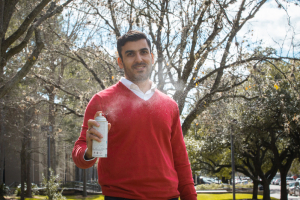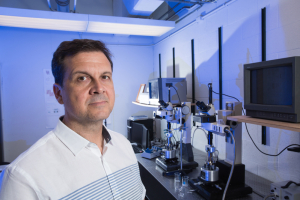Ghasemi and Vekilov in the Spotlight
Two Cullen College of Engineering faculty won the University of Houston’s Awards for Excellence in Research, Scholarship and Creative Activity for the 2018-19 academic year. Hadi Ghasemi was recognized in the “Assistant Professor” category and Peter Vekilov was honored in the “Professor” category.
The awards, given each year by the UH Division of Research, recognizes faculty with a growing record of outstanding research, scholarship and creative contributions, who are emerging leaders in their fields.
Hadi Ghasemi, Bill D. Cook Assistant Professor of mechanical engineering, is renowned for his work involving innovative materials and icephobicity. Earlier this year, he and his collaborators announced a research breakthrough where they created a durable silicone polymer coating capable of repelling ice from any surface based on a new theory in physics called stress localization.
The new material uses elastic energy localization where ice meets the material, triggering cracks at the interface that slough off the ice. The material, which is applied as a spray, can be used on any surface. Testing indicates it will last for more than 10 years, with no need to reapply.
Previously, Ghasemi created a biologically-inspired anti-icing material that can withstand critically low temperatures. The material – which is applied to surfaces as a coating – was one of three winners of the NASA iTech competition in 2017.
The anti-icing coating was inspired by the tiny North American Wood Frog, a creature that can freeze up to 65 percent of its total body water without dying. NASA chose Ghasemi’s project from entries submitted by over 130 organizations across the U.S. for its potential to broadly impact human life on earth and the future of space travel.
Once Ghasemi had plenty proof of concept for his novel material, he partnered with students in his Nano Therm lab to launch the startup SurfEllent and began marketing the product to consumers.
Other materials created by Ghasemi and his research team include a new magnetic slippery surface (MAGSS), which can be applied to any surface – ceramic, polymers or metals. While pursuing postdoctoral work at the Massachusetts Institute of Technology (MIT), he is credited with creating a low-cost graphite “solar sponge” to convert sunlight into steam for potable water.
He runs the UH Nano Therm Lab that explores research in the field of thermodynamics, heat transfer, and nanotechnology.
Peter Vekilov, John and Rebecca Moores Professor of chemical and biomolecular engineering and chemistry, discovered the two-step nucleation mechanism – called the Vekilov mechanism – where crystal nuclei form inside pre-existing dense liquid droplets. The impact of this finding will allow biomedical researchers to gain a better understanding of how pathogenic crystals of proteins and small molecules form in the body.
His research in the pathological mechanism of malaria has an unmatched potential to break through in the fight against malaria. He identified the atomic structure of the hematin crystal surface sites that are available for interaction with different drugs, allowing for molecular-level modeling of the action drugs as well as screening for new candidate molecules. In a recent publication in the Proceedings of the National Academy of Sciences, Vekilov described three different pathways whereby antimalarial drugs suppress the crystallization of hematin and proposed the first molecular mechanisms for cooperativity between drug molecules. He also proposed, synthesized and tested a new drug possibility with the potential to treat strains of parasites that are resistant to current treatments. All of this work was enabled by Vekilov’s foundational work on nucleation and crystal growth, and could impact the lives of billions of people.
In recent years, Vekilov has focused on the nucleation and growth of amyloid fibrils. Fibrils and certain oligomers have been implicated as the main carrier of neurotoxicity in Alzheimer’s disease. Work by the Vekilov group, published in iScience, has identified a new phase of the protein p53, mesoscopic p53 rich oligomers, that serve as loci for the nucleation of the amyloid fibrils. Vekilov and his students characterized the transition state for growth of A beta fibrils that is crucial for the understanding of the action of potential drugs that suppress amyloid aggregation.
He leads the Vekilov Research Group at UH with a primary focus on phase transitions that occur in protein solutions. The group investigates the nucleation of the polymer fibers of the sickle cell hemoglobin that underlie the deadly sickle cell anemia and the nucleation of protein crystals.
Both professors will be honored at the Faculty Excellence Award Dinner at the Hilton University of Houston on Thursday, April 18.

